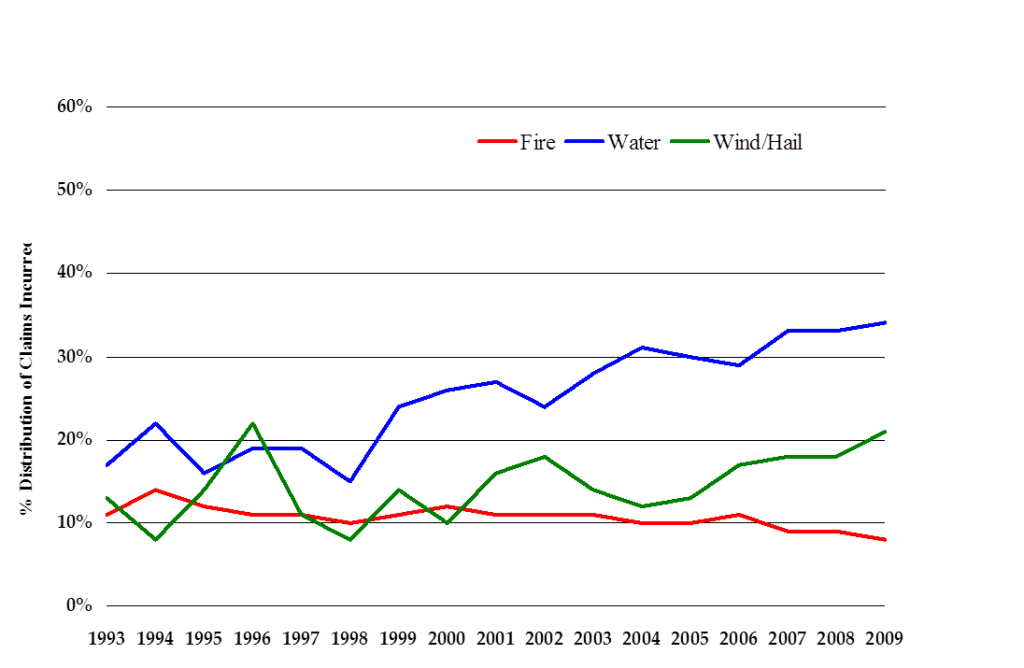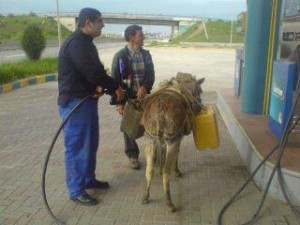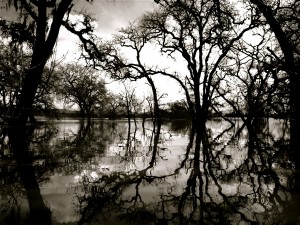“…and chaos in the elements. The temperatures unbalanced, grand snow mountains – hard firm glaciers – will melt and disappear. Rivers and lakes becoming scarce …” – Tibetan poem on global warming
The weather is changing globally, but it’s the sewer backed-up that will bring climate change home to many Canadians.
Lately, I’ve been struggling with the implications and magnitude of global warming. It’s hard to absorb something this vast, although I know it’s important to make a shift in the scale of my perspective.
Sea level change is a good example. Tides are rising because of simple physics: global temperatures are rising, water expands as it gets warmer, and melting ice caps grow the pool. It’s dramatic but totally predictable. Coastal communities are weighing options for higher dikes, raising homes on stilts, or relocating neighbourhoods. The island nation of Kiribati is considering a move to Fiji.
This is big.
 Fundamentally, global change is hard to think about because it is deeply unsettling – we expect the world around us to be stable. Instead, our assumptions are rocking around in rough currents. This post is about getting to acceptance and the work at hand, rather than lingering in anger, denial, or bargaining.
Fundamentally, global change is hard to think about because it is deeply unsettling – we expect the world around us to be stable. Instead, our assumptions are rocking around in rough currents. This post is about getting to acceptance and the work at hand, rather than lingering in anger, denial, or bargaining.
A few weeks ago, I met a flood-control engineer and a climate modeller working on sea level rise for the Province of B.C. They were fired up about their work, but admitted that adaptation is still a smaller-scale effort than work on climate mitigation: controlling greenhouse gas emissions. While reducing emissions will soften the effects, most forecasts show continued warming and changes under all emissions scenarios.
So, what should we actually do next to prepare?
The question of how and when changes take place has become of great interest to public and private investors. An adaptation think-tank has been set up at Simon Fraser University, and the University of Western Ontario has an Institute for Catastrophic Loss Reduction. The National Roundtable for the Environment and the Economy has written a series of reports about the business-response to climate change, and the Intergovernmental Panel on Climate Change just released a study on managing the risks of extreme events.
It is telling that the insurance industry is one of our leading sectors for climate adaptation.

Homeowners insurance claims, 1993-2009. Source Insurance Bureau of Canada, Homeowners exhibit. Thanks to Robert Tremblay.
The problem? Stationarity is dead. In the language of engineers this means we can’t reliably use the past to predict the future. The old way of assigning risk of storms, floods, windstorms and droughts, based on the historical record, isn’t terribly useful anymore. A “100-year flood” (with a 1/100 chance any given year), might happen every 20 years. This uncertainty contributes to the debate about how to proceed.
But uncertainty is about risk – risk assessment, risk tolerance, risk management – and as a society, we already have well-established ways to respond to risk.
Some of the most interesting talks at a national climate forum in March were about insurance, and infrastructure assessments. The matter-of-fact delivery of the representative from the Insurance Bureau of Canada felt like a splash of cold water. They deal in data, and use phrases like “the climate-components of sewer back-ups,” and “distinctive risk unit indicators.” I was riveted – but distracted by nagging inner questions about my own home coverage.
The insurance industry sees a steady increase in water-related claims. Some relate to the increase in upholstered basements with big-screen TVs, but (controlling for the “man-cave effect”) a large portion relates to increased intensity of rainfall, and wind-storms. As (I learned) insurance is a “risk-transfer tool,” our premiums will inevitably increase to compensate.
For its part, Engineers Canada (which certifies all our engineering schools) has been working on risk assessment protocols for publicly-owned bridges, roads, and drainage systems. While storm drains and subsequent sewer back-ups do not have the drama of sea level rise, they will likely bring climate change home to more Canadians. There is active discussion about where the liabilities lie, and the renewal and resizing of aging infrastructure.
The take-home message for me is that, in small steps, the big-boys in the business community and government are beginning to take climate very seriously. The changes will touch our lives in unpredictable ways, but it is far better that we narrow the range of potential consequences – find vulnerabilities, and cost-out solutions.
Writing this, I remember one summer I spent in Nova Scotia – young and naive, with small children at home. When we heard a hurricane was coming, I simply had no idea what to expect, or what to do. Leaving my husband to batten down the hatches, my one thought was – if the power goes out, we’ll need some comfort food – so I baked a chocolate cake. In retrospect, a charming but completely ineffective response.
 Tibetans, Northerners, and citizens of low-lying island countries have been among the first to feel the shift of climate, and this is a good time for the rest of us to get ready.
Tibetans, Northerners, and citizens of low-lying island countries have been among the first to feel the shift of climate, and this is a good time for the rest of us to get ready.
It is interesting and heartening to remember that, although the climate is changing, people and culture stay the same. We have great resilience.
Trailer for the “Climate Insights – bite size” video series.




I just read on the Waters Next twitter feed that the National Roundtable for the Environment and Economy got the axe in the federal budget. If you are interested in the reports on climate and the economy, you might want to download them soon.
Congratulations on your blog! I keep saying I’m going to do one, and then never get around to it…so I admire your commitment. Well done!!
Thanks,
Jo
Hi Joanne,
Thanks for the comment, and for your work on climate change outreach in the Okanagan. Anna
Pingback: Mud-bogging and other ways we love the land too hard | | Building BridgesBuilding Bridges
Pingback: The Value of Water | | Building BridgesBuilding Bridges
Pingback: Not waiting for Noah | Building Bridges